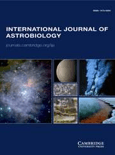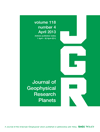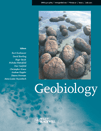
International Journal of Astrobiology
Scope & Guideline
Pioneering Insights into the Universe’s Living Possibilities
Introduction
Aims and Scopes
- Astrobiology Research:
The journal extensively covers research on the origins, evolution, and distribution of life in the universe, including studies on extremophiles, microbial life in extreme environments, and potential biosignatures. - Planetary Habitability:
A significant focus is placed on understanding the conditions necessary for life on other planets, including analysis of exoplanets, Martian environments, and icy moons, often involving geological and atmospheric assessments. - Prebiotic Chemistry:
Research into the chemical processes that may lead to the emergence of life is a core theme, with studies exploring prebiotic pathways, molecular evolution, and the role of various environmental factors. - Ethical and Philosophical Considerations:
The journal addresses the ethical implications of astrobiological research, including discussions on the moral status of extraterrestrial life and the responsibilities of humanity as a multiplanetary species. - Interdisciplinary Approaches:
The journal promotes transdisciplinary methodologies, integrating insights from various fields such as ecology, geology, physics, and sociology to enhance understanding of astrobiological phenomena.
Trending and Emerging
- Microbial Life in Extreme Environments:
There is a growing interest in studying microbial communities that can survive in extreme conditions, such as those found in Martian analogs and spacecraft clean rooms, reflecting an emphasis on understanding life's resilience. - Astrobiological Ethics and Philosophy:
Increasingly, papers are addressing the ethical implications of astrobiological research, including the moral status of potential extraterrestrial life and the responsibilities of humanity towards it. - Technological Innovations in Astrobiology:
The use of advanced technologies, such as μ-mapping X-ray fluorescence spectrometry and robotic exploration, is gaining prominence, highlighting the role of innovation in astrobiological research. - Interdisciplinary Collaborations:
There is a notable trend towards collaborative projects that integrate diverse fields, such as ecology, psychology, and astrobiology, indicating a recognition of the complexity of life in the universe. - Astrobiology and Climate Change Connections:
Emerging research is beginning to explore the links between astrobiology and current climate issues on Earth, suggesting that understanding life's potential elsewhere can inform our approaches to sustainability.
Declining or Waning
- Traditional SETI Approaches:
Research focused solely on traditional Search for Extraterrestrial Intelligence (SETI) methodologies has waned, as newer interdisciplinary approaches that incorporate astrobiological insights gain traction. - Historical Astrobiological Narratives:
Papers that primarily focus on historical narratives of astrobiology without current empirical relevance are becoming less frequent, indicating a shift towards more contemporary and applicable research. - Speculative Theories of Extraterrestrial Life:
Theoretical discussions without substantial empirical backing related to the nature of extraterrestrial civilizations or their technologies have decreased, suggesting a movement towards more evidence-based studies.
Similar Journals

Geosciences
Advancing Knowledge in Earth and Planetary Sciences.Geosciences is a prestigious open-access journal published by MDPI, dedicated to advancing research in the field of Earth and Planetary Sciences. Since its inception in 2011, this journal has fostered a collaborative environment for the dissemination of innovative ideas and findings, contributing significantly to the academic community's understanding of complex geological processes. The journal has achieved a commendable 2023 ranking in the second quartile (Q2) within its category, highlighting its impact and relevance in the field, with a Scopus rank of #41 out of 195 journals, placing it in the 79th percentile. With an aim to span a broad range of topics from environmental geology to planetary exploration, Geosciences is pivotal for researchers, professionals, and students looking for an accessible platform to share their work and stay informed of the latest developments. As a fully open-access journal, it ensures that high-quality research is freely available, fostering greater dissemination of knowledge across the globe.

Planetary Science Journal
Democratizing Discovery: Open Access to the Secrets of the UniverseThe Planetary Science Journal, published by IOP Publishing Ltd in the United Kingdom, stands at the forefront of research in the fields of planetary science, astronomy, and geophysics. With its open access model established since 2020, this journal aims to democratize access to groundbreaking findings that explore the complex interactions between celestial bodies and their atmospheres, geology, and climates. Recognized for its high quality, the 2023 impact factor places the journal in the prestigious Q1 category across multiple disciplines, including Astronomy and Astrophysics, Earth and Planetary Sciences, and Space and Planetary Science. Ranked favorably among its peers, with notable scores in Scopus rankings, the journal seeks to contribute significantly to advancing our understanding of planetary systems and their formation, encouraging interdisciplinary collaboration among researchers, professionals, and students alike. By fostering a community of innovation and inquiry, the Planetary Science Journal is committed to publishing pioneering research that addresses critical questions of our universe.

NPJ Microgravity
Enabling Open Access to Cutting-Edge Microgravity StudiesNPJ Microgravity, published by NATURE PORTFOLIO, is a premier open-access journal dedicated to advancing research in microgravity environments, complementing extensive studies in fields as diverse as Agricultural and Biological Sciences, Biochemistry, Materials Science, Medicine, Physics, and Space and Planetary Science. Since its inception in 2015, the journal has rapidly established itself as an influential platform for disseminating cutting-edge research, evidenced by its Q1 quartile rankings across multiple disciplines and impressive Scopus rankings, including a top 10 placement in Physics and Astronomy. Based in the United Kingdom with an address of HEIDELBERGER PLATZ 3, BERLIN 14197, GERMANY, NPJ Microgravity not only champions innovative studies but also promotes collaborations that can translate scientific knowledge into tangible benefits for society. As an open-access journal, it offers unparalleled accessibility to high-quality research, making it an essential resource for researchers, professionals, and students with a keen interest in the applications and implications of microgravity research.

Boletin de Ciencias de la Tierra
Championing Open Access to Earth Science ResearchBoletin de Ciencias de la Tierra is a distinguished open-access journal dedicated to the field of Earth and Planetary Sciences, published by the Universidad Nacional de Colombia, Sede Medellín. Since its transition to open access in 2006, it has become an essential platform for disseminating high-quality research that addresses critical geological and environmental issues pertinent to Latin America and beyond. With an ISSN of 0120-3630 and an E-ISSN of 2357-3740, the journal aims to promote scientific dialogue and share innovative findings in various areas including geology, geochemistry, and environmental sciences. Although it currently holds a Scopus rank of #184 in the General Earth and Planetary Sciences category, indicating a percentile of only 5, Boletin de Ciencias de la Tierra is committed to fostering a rich academic discourse and enhancing the visibility of scholarly works. Situated in Medellín, Colombia, the journal serves as a vital resource for researchers, professionals, and students looking to explore advancements and participate in the global conversation on Earth sciences.

AGU Advances
Connecting Researchers to Tackle Global ChallengesAGU Advances, published by the American Geophysical Union, is a premier Open Access journal established in 2020, dedicated to advancing the field of Earth and Planetary Sciences. With an impressive Q1 ranking in the 2023 category of Earth and Planetary Sciences (miscellaneous) and a Scopus rank of #81/195, it serves as a vital platform for researchers, professionals, and students to share their findings and innovations. The journal fosters a collaborative environment, encouraging interdisciplinary approaches and high-quality research that addresses the fundamental questions of our planet and beyond. With its commitment to accessibility, AGU Advances ensures that cutting-edge research is available to a global audience, supporting the dissemination of knowledge that is crucial for addressing current and future scientific challenges. For those keen on contributing to or accessing groundbreaking studies in this dynamic field, AGU Advances is an invaluable resource.

BULLETIN OF GEOSCIENCES
Unveiling the Secrets of Earth’s Processes and EnvironmentsBULLETIN OF GEOSCIENCES, published by the prestigious Czech Geological Survey, stands as a pivotal resource in the fields of Earth and Planetary Sciences and Environmental Science. Since its inception in 2003, the journal has been committed to advancing knowledge through high-quality research, currently holding a commendable Q2 ranking in both disciplines. With its focus on diverse and innovative topics, BULLETIN OF GEOSCIENCES provides an essential platform for researchers, professionals, and students aiming to disseminate and access impactful studies. The journal is indexed in Scopus, ranking #78/195 in General Earth and Planetary Sciences and #110/233 in General Environmental Science, reflecting its significant contribution to academia. Publishing from Prague, Czech Republic, this journal invites contributions that illuminate the interactions between geological processes and environmental phenomena, ensuring an inclusive and accessible approach to crucial global issues.

JOURNAL OF GEOPHYSICAL RESEARCH-PLANETS
Connecting Scholars to the Universe's WondersThe JOURNAL OF GEOPHYSICAL RESEARCH-PLANETS, published by the American Geophysical Union, stands at the forefront of planetary science research, serving as an essential resource for scholars and practitioners exploring the complexities of planetary bodies within our solar system and beyond. With its ISSN 2169-9097 and E-ISSN 2169-9100, this respected journal has demonstrated a notable impact within the academic community, holding a prestigious Q1 ranking in multiple categories including Earth and Planetary Sciences, Geochemistry and Petrology, Geophysics, and Space and Planetary Science as of 2023. Its Scopus rankings further highlight its significance, placing it among the top echelons of Earth and planetary sciences—particularly as it ranks 12th in its broad category. While not an open access platform, the journal provides invaluable insights into planetary processes, geological phenomena, and the ongoing exploration of celestial environments, making it indispensable for researchers, professionals, and students dedicated to advancing our understanding of planetary systems. Established in 1996 and continuing to publish until 2024, the journal remains committed to fostering innovation and collaboration in this dynamic field of study.

EARTH AND PLANETARY SCIENCE LETTERS
Unveiling Earth's Secrets Through Rigorous ResearchEARTH AND PLANETARY SCIENCE LETTERS, published by ELSEVIER, stands as a premier academic journal in the fields of Earth and Planetary Sciences, Geochemistry and Petrology, Geophysics, and Space and Planetary Science. Since its inception in 1966 and continuing to 2024, the journal has consistently maintained an impressive reputation, ranking in the top quartile (Q1) across several categories, highlighting its vital role in advancing scholarly research. With a Scopus ranking of #4 in both Geophysics and Geochemistry and Petrology, and a notable 97th percentile in multiple Earth sciences categories, EARTH AND PLANETARY SCIENCE LETTERS provides a platform for groundbreaking research, encouraging rigorous investigation and dissemination of knowledge. While not available as an Open Access publication, the journal remains highly accessible to academics and professionals worldwide, providing invaluable insights and fostering discussions that influence the future of Earth sciences. Whether you are a researcher, educator, or student, this journal is a crucial resource for understanding our planet and its processes.

Geobiology
Fostering Dialogue on Climate Change and BiodiversityGeobiology, published by WILEY, is a prestigious journal at the forefront of interdisciplinary research in Earth and Planetary Sciences, Ecology, and Environmental Science. With an ISSN of 1472-4677 and an E-ISSN of 1472-4669, this journal has achieved remarkable recognition as evidenced by its Q1 categorization in multiple relevant fields, including Earth and Planetary Sciences, Ecology, and Environmental Science, according to the 2023 quartile rankings. Covering a diverse range of topics from biogeochemical cycles to the impacts of climate change on biodiversity, Geobiology serves as a vital platform for researchers, professionals, and students alike. The journal boasts impressive Scopus rankings, placing it within the top tiers of its fields, which is indicative of its significant influence and contribution to advancing knowledge. Although it does not operate under an Open Access model, Geobiology ensures widespread reach and accessibility, allowing for impactful dialogues within the scientific community. Researchers are encouraged to submit their findings and engage with cutting-edge studies to advance our understanding of the interplay between biological and geological processes.

Journal of Advances in Modeling Earth Systems
Pioneering Insights in Environmental Chemistry and Global Change.Journal of Advances in Modeling Earth Systems, published by the American Geophysical Union, is a foremost open access journal that has been contributing to the fields of Earth and Planetary Sciences, Environmental Chemistry, and Global and Planetary Change since its inception in 2009. With a remarkable impact factor and consistently maintained Q1 category rankings across several key disciplines, this journal stands out as a leading platform for disseminating innovative research and modeling advancements critical to understanding Earth systems. It is ranked in the top 5% of Earth and Planetary Sciences and Environmental Chemistry, emphasizing the high caliber of work published within its pages. The journal engages a diverse audience, including researchers, professionals, and students, by providing a comprehensive repository of cutting-edge studies and findings that are openly accessible to the global scientific community. With its headquarters in the United States and converging research from 2011 to 2024, the Journal of Advances in Modeling Earth Systems remains an essential resource for those seeking to explore and advance the frontiers of environmental science and modeling techniques.